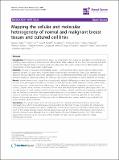| dc.contributor.author | Keller, Patricia J | |
| dc.contributor.author | Lin, Amy F | |
| dc.contributor.author | Arendt, Lisa M | |
| dc.contributor.author | Klebba, Ina | |
| dc.contributor.author | Jones, Ainsley D | |
| dc.contributor.author | Rudnick, Jenny A | |
| dc.contributor.author | DiMeo, Theresa A | |
| dc.contributor.author | Gilmore, Hannah L. | |
| dc.contributor.author | Jefferson, Douglas M | |
| dc.contributor.author | Graham, Roger A | |
| dc.contributor.author | Naber, Stephen P | |
| dc.contributor.author | Schnitt, Stuart Jay | |
| dc.contributor.author | Kuperwasser, Charlotte | |
| dc.date.accessioned | 2012-03-29T18:36:18Z | |
| dc.date.issued | 2010 | |
| dc.identifier.citation | Keller, Patricia J., Amy F. Lin, Lisa M. Arendt, Ina Klebba, Ainsley D. Jones, Jenny A. Rudnick, Theresa A. DiMeo, et al. 2010. Mapping the cellular and molecular heterogeneity of normal and malignant breast tissues and cultured cell lines. Breast Cancer Research 12(5): R87. | en_US |
| dc.identifier.issn | 1465-5411 | en_US |
| dc.identifier.uri | http://nrs.harvard.edu/urn-3:HUL.InstRepos:8462366 | |
| dc.description.abstract | Introduction: Normal and neoplastic breast tissues are comprised of heterogeneous populations of epithelial cells exhibiting various degrees of maturation and differentiation. While cultured cell lines have been derived from both normal and malignant tissues, it remains unclear to what extent they retain similar levels of differentiation and heterogeneity as that found within breast tissues. Methods: We used 12 reduction mammoplasty tissues, 15 primary breast cancer tissues, and 20 human breast epithelial cell lines (16 cancer lines, 4 normal lines) to perform flow cytometry for CD44, CD24, epithelial cell adhesion molecule (EpCAM), and CD49f expression, as well as immunohistochemistry, and in vivo tumor xenograft formation studies to extensively analyze the molecular and cellular characteristics of breast epithelial cell lineages. Results: Human breast tissues contain four distinguishable epithelial differentiation states (two luminal phenotypes and two basal phenotypes) that differ on the basis of CD24, EpCAM and CD49f expression. Primary human breast cancer tissues also contain these four cellular states, but in altered proportions compared to normal tissues. In contrast, cultured cancer cell lines are enriched for rare basal and mesenchymal epithelial phenotypes, which are normally present in small numbers within human tissues. Similarly, cultured normal human mammary epithelial cell lines are enriched for rare basal and mesenchymal phenotypes that represent a minor fraction of cells within reduction mammoplasty tissues. Furthermore, although normal human mammary epithelial cell lines exhibit features of bi-potent progenitor cells they are unable to differentiate into mature luminal breast epithelial cells under standard culture conditions. Conclusions: As a group breast cancer cell lines represent the heterogeneity of human breast tumors, but individually they exhibit increased lineage-restricted profiles that fall short of truly representing the intratumoral heterogeneity of individual breast tumors. Additionally, normal human mammary epithelial cell lines fail to retain much of the cellular diversity found in human breast tissues and are enriched for differentiation states that are a minority in breast tissues, although they do exhibit features of bi-potent basal progenitor cells. These findings suggest that collections of cell lines representing multiple cell types can be used to model the cellular heterogeneity of tissues. | en_US |
| dc.language.iso | en_US | en_US |
| dc.publisher | BioMed Central | en_US |
| dc.relation.isversionof | doi:10.1186/bcr2755 | en_US |
| dc.relation.hasversion | http://www.ncbi.nlm.nih.gov/pmc/articles/PMC3096980/pdf/ | en_US |
| dash.license | LAA | |
| dc.title | Mapping the Cellular and Molecular Heterogeneity of Normal and Malignant Breast Tissues and Cultured Cell Lines | en_US |
| dc.type | Journal Article | en_US |
| dc.description.version | Version of Record | en_US |
| dc.relation.journal | Breast Cancer Research | en_US |
| dash.depositing.author | Gilmore, Hannah L. | |
| dc.date.available | 2012-03-29T18:36:18Z | |
| dash.affiliation.other | HMS^Pathology | en_US |
| dash.affiliation.other | HMS^Pathology | en_US |
| dc.identifier.doi | 10.1186/bcr2755 | * |
| dash.authorsordered | false | |
| dash.contributor.affiliated | Gilmore, Hannah L. | |
| dash.contributor.affiliated | Schnitt, Stuart | |


